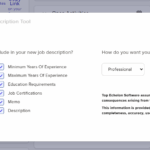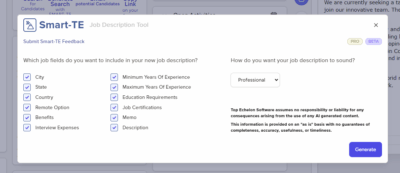Recruiting today is not the same as it was even a few short years ago. The market is candidate driven, meaning the talent you’re seeking is receiving multiple offers at a time, being contacted by recruiters regularly, and in the position to change employers easily when their work stops being fulfilling. If you or your team are looking at making your recruiting more effective as you navigate these market changes, or are just jumping into recruiting, join us for our five-part series about effective recruiting in a candidate driven market.
Strategic Planning and Determining Need
Determining staffing needs can at times be some of the more critical decisions employers are faced with. There can be the tendency to automatically back-fill a termination, or add to staff based on a recent increase in workload. The key to successful staffing lies in a strategic plan based upon a clear assessment of long-range business goals, existing skill set, trends in work volume, and evaluating your skills gap. Planning appropriately will ensure you are well positioned to hire the right person for the position and the team.
Assessing Need
It can be common to want to replace someone immediately upon their exit, but this is an ideal time to step back and assess the true needs of the team and the department. Whether a vacancy is open because of a resignation or termination, or, you are considering adding a new position, there are several things you’ll want to assess first.
- Does the department still require this role? Take a look at the work that was being done. Could the accountabilities of that role be dispersed among the existing team members without placing an unfair burden on them? Analyze the work hours, part-time and full-time status of the current associates, and any potential changes in status some may be looking to make before determining the status of the position you are looking to fill. Are there any existing team members voicing a desire for growth or a change in responsibilities?
- Consider the existing workload of the team and the department. What are the trends that the department experienced throughout the last twelve months? Is this the optimal time to be filling the position, or should it wait? What changes in the business can you anticipate in the next six to 12 months? Does the department have this role budgeted appropriately? Now is a good time to work with your compensation analyst to assess on-going budget requirements for this role, especially if you are adding a new position.
- Is there an available and qualified recruiting staff in place to assist in filling this position? Do you have high-quality recruiting software in place? For example, if you’re preparing for upcoming seasonal hiring, systems like Top Echelon’s can be up and running in a week.
- Is there staff available to train and mentor a new employee at this time? If you don’t onboard someone well, you run the risk of losing them too soon.
Evaluating Position
Once it is determined that a vacancy should be filled, there are still some questions to answer before proceeding. Start by assessing the following:
- Especially in the case of a replacement, review the position to make any potential changes to tasks and responsibilities that need updating or eliminating, perhaps as a result of a change in technology or systems now being used, or new skills or expertise needed to fulfill the expectations of the role.
- Analyze the core competencies of the team and the department as a whole. What core skills are missing? Are there any skills that could be used in the near future?
- Are there any expected changes coming within the team or department that may affect this position?
- Work with your compensation analyst to ensure that the role is properly classified.
Creating a Job Description
Before you can begin recruiting to fill your position, it’s imperative that you have a quality job description prepared. There can be a tendency to be overly restrictive and not think about those items that are showstoppers versus “nice-to-have’s”. Overall, one of the most critical elements of a job description are the core competencies. These are used to establish expectations and requirements of the position, create interview questions, and evaluate the performance of that position. In addition to core competencies, there are several key things that a job description must have:
- Job Title. These should be consistent throughout your department and organization.
- Company Name. Especially for those organizations with several divisions or entities, you will want to be very clear about which vertical this position will be aligned with.
- Location. This is critically important for organizations with multiple divisions and locations.
- Travel Requirements. Don’t sugar-coat this, be sure that your potential new hire knows exactly what he/she can expect as it relates to the percentage of travel this role will require.
- Work Hours. Indicate whether or not this position is full-time or part-time, the shift, beginning and ending times, and days of the week that this position requires.
- Working Conditions. Describe the environment that he/she will be working in.
- Years of Experience. Indicate the minimum number of related years of experience required to qualify for this position.
- Reporting Structure. Include to whom this person will report, and the job titles of those people who will report (if any) to this person.
- Overview. Provide a brief description of what the department responsibilities and accountabilities are.
- Essential Functions. Describe the main duties and responsibilities required to be completed and performed by this person, with or without accommodation.
- Skills. List the skills and abilities included in this position, to include safety, managerial/supervisory levels, working relationships, and corporate/team and personal objectives.
- Requirements. Explain the knowledge, experience, and educational background required to qualify for this position.
- Pay. Indicate whether or not this position is an hourly or salaried position. You may also want to include any additional benefits provided.
- Compliance. If you are an EEO employer, this must be indicated on each job description. You will also want to include language as it relates to diversity and Affirmative Action.
- Physical Requirements. To be compliant with the Americans with Disabilities Act (ADA) you’ll want to be especially thoughtful about how physical requirements are worded so that you are not improperly exclusionary. As an example, requiring employees to have the ability to “stand”, that language would be exclusionary if the position requires the employee to use a cash register since a simple accommodation would be to provide a stool.
Key Performance Indicators
If you’re a larger organization with a recruiting team, before beginning the recruiting process, you will want to establish some Key Performance Indicators (KPI’s) to measure the results and evaluate your success against them.
- Determine which KPI’s are important for the recruiting function and for the business.
- KPI’s should be included in each recruiter’s performance plan.
- The recruiting process is commonly measured on the following: Time to Fill (TTF), Cost Per Hire (CPH), Quality of Hire (QOH, evaluated by hiring manager based upon time to productivity/retention).
- Be sure to continuously re-evaluate KPI’s to make sure they are in line with corporate and economic changes.
Once you have successfully gone through these steps and answered these important questions, you are ready to begin the recruiting process.
To learn more about how Top Echelon Software can assist you in creating a quality candidate experience, contact us today!








